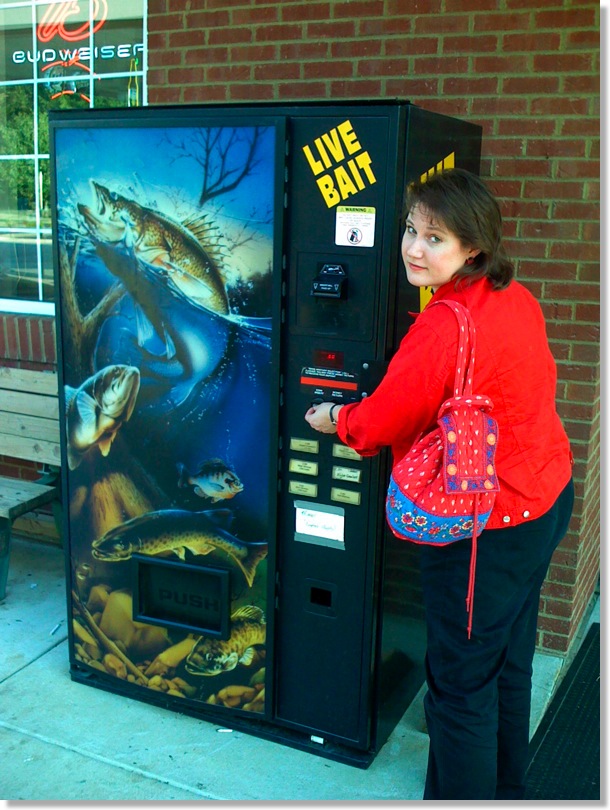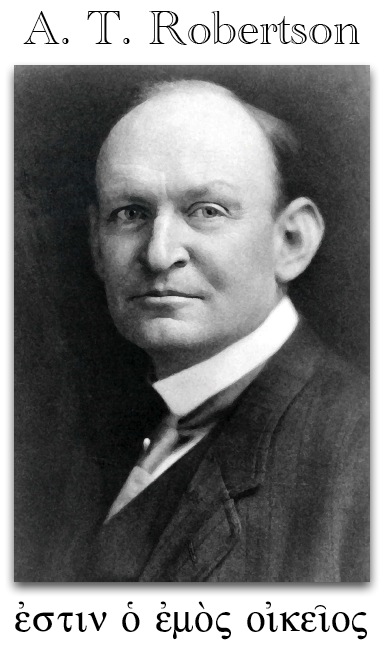I'm Gonna Have to Say "No" to Facebook (and the rest)
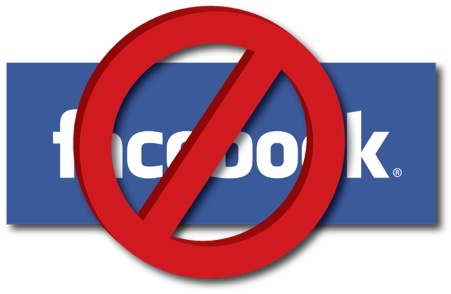
And I never will be.
Not too long after Facebook friend invites started pouring in, one friend who requested I add her, and after obviously seeing a neglected profile and no interaction sent me a text message saying, "You've got so much to learn about Facebook!" Of course I interpreted her message as saying, "Ha ha, I know more about something on the internet than you do for once!"
Well, not exactly true. And perhaps if you're one of the folks with whom I've exchanged invites you feel the same way. But let me explain my position. Here's the thing... I've got this website that you're on right now called This Lamp. In spite of the fact that I haven't had time to update the site much lately, Sitemeter tells me that I'm still receiving over 400 hits a day, which is pretty healthy for a personal website, especially a neglected one, in my opinion. And that's not even counting the folks who read This Lamp strictly on the RSS feed which I'm not tracking at the moment. And I wonder how many pastors, politicians and other public figures would love to have that kind of audience on a daily basis? Thus, with my limited time, if I am going to invest my online efforts anywhere, I think I should simply do it here.
In fact, I'm going to completely cancel my FaceBook profile in a few days. There's no point in keeping it. I'm warning you now. I have no idea what happens when one of your FaceBook "friends" disappears. Just don't take it personally.
So am I being anti-social by saying no to social networking? No. This website can be quite the social place at times as are some of yours. Frankly, I consider myself a very social person, and if you've ever received an email from me, you'll notice that I even give out my cell phone number freely. Plus, I've got four different instant messaging identities because I have different friends who use different systems. I often have all four running during the day. Feel free to add me:
AIM/iChat: rmansfield@mac.com
Microsoft Messenger: rmansfield@hotmail.com
Yahoo Messenger: rick_mansfield
ICQ: 7367293
Feel free to chat away with me on any of the above. You'll find I'm quite social. But as for FaceBook, and last year's "in" social site MySpace and all the other social networking tools (Twitter, LinkedIn, and all the new ones that launch each day), I'm going to have to pass.
Who's got the time?
First Look: A Reader's Greek New Testament, Second/Revised Edition
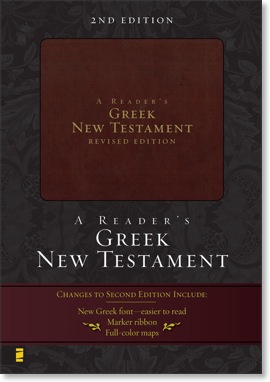
SOME BACKGROUND: THE FIRST EDITION
I've always found A Reader's Greek New Testament (RGNT from this point forward) to be an extremely practical resource. The RGNT addresses the issue that while there are over 5,000 distinct words in the Greek NT, the reality is that many of this words only occur a few times or even in single occurances. While it's an admirable goal for a student of Greek to memorize every word, it's not a reality for most. Most introductory grammars, in fact, only cover a little over 300 words, but these words occur so frequently that they account for roughly 80 of the entire New Testament. But that remaining 20% is still enough from keeping the average person who has a familiarity with Greek from sitting down and reading the New Testament in its original language as easily as one might read an English translation. In fact, in my experience and observation, I've known personally of only about two or three people who can really read the Greek NT without stumbling. Oh, sure, the dirty little secret is that any of us can read a passage just fine when we've taken the time to work through it ahead of time. But as soon as someone asks us a question about a different passage--one that we haven't prepared beforehand, we stumble and stammer as we try to read it in a quick and efficient manner.
The RGNT is noted for including lexical forms for all words of the Greek New Testament that occur 30 times or less. If this sounds like a crutch, think again. The reader still has to know his or her Greek grammar fairly well to use this resource. In fact, I tend to carry the first edition of the RGNT with me to church on Sundays. If I need to look up something quickly, and come across a word that's not part of my working vocabulary, I can look at the footnote at the bottom of the page. It's not realistic for me to carry a lexicon with me to church, and I usually don't have my MacBook so that I can access such tools in Accordance. Perhaps one day, I'll make time to memorize all 5000+ words in the Greek NT, but for right now it's not a practical goal and the RGNT is an ideal solution.
The other distinct feature of the RGNT first edition has to do with its textual basis. Most might assume that this is simply an edition of the current UBS/NA eclectic Greek text with a special apparatus. Not so. The Greek text in this edition is actually one that has been retrofitted, so to speak, to match the text that underpins the New International Version. The reality is that every translation committee makes decisions that sometimes causes them to choose a different textual route than the majority opinion of the UBS/NA committees. The RGNT first edition has about 200 instances, all noted in the footnotes, where its text differs from the standard text.
IMPROVEMENTS/CHANGES IN THE SECOND EDITION
New Greek font. I don't know if the font itself is actually a different font, but the main difference from the first edition is that the text in the second edition is not in italics. And I say, "Thank goodness!" My major complaint about the first edition of the RGNT is the italicized text that is extremely difficult to read. I have no idea why some publishers of Greek texts like to do this. The UBS 4th edition Greek NT uses a horribly thin italicized text also making it difficult to read. Thankfully, Zondervan changed this policy in the RGNT 2nd edition.
However, the font itself does look slightly smaller than the original edition. I've made a comparison in the graphic below that displays the first page of Matthew's Gospel on the left in the first edition and with the second edition on the right (note that the image below is not actual size).
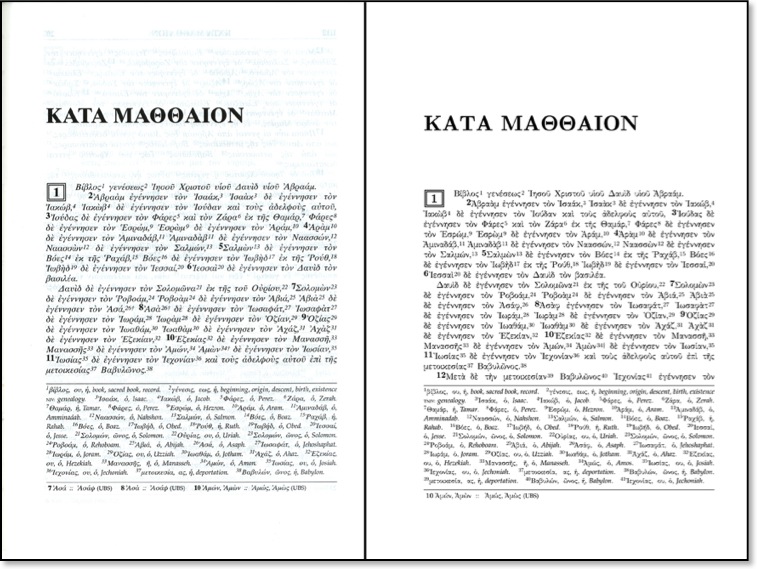
The observant reader may notice that there's slightly more text (most of Matt 1:12) on the second edition page. Therefore, the font is either tighter or smaller. Zondervan offers a PDF sample of the RGNT2 featuring the first five pages of Matthew. The second edition ends with Matt 3:17 while the equivalent page in the fist edition ends with 3:15. Two verses--is that a big deal? Probably not, but there is definitely an attempt to use fewer pages. Why? Because while there are more features in the RGNT2, but there are actually fewer pages than the first edition. Therefore, an attempt was made to conserve space. And while I wish Zondervan had not chosen to use a tighter/smaller font, I will say that regardless, the new text is much easier to read than the italicized text of the first edition.
But that brings us to another issue, and frequent readers of This Lamp will have to pardon a familiar complaint that I've discussed many times before. This New Testament, (presumably) like its predecessor is a thinline. How do I know this? Well, in spite of the fact that complete measurements have not been released, we do know a few things. I'm guessing the dimensions are a bit wider because the outer margin on each page is wider (see more below). We also know that although there is about a twenty page difference in the two editions, the weight is comparable (1.065 lbs. for the first edition vs. 1 lb. for the second edition). Thickness measurements for the second edition have not been released, but the first edition is 7/10 of an inch thick. Since the two editions weigh virtually the same, I can only assume that the second edition will be just as thin.
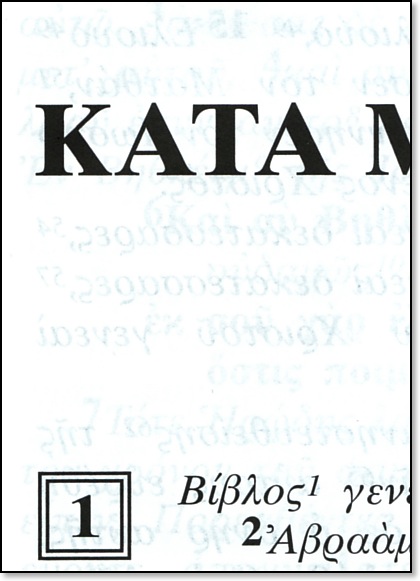
Personally, I hope that one day, publishers will get over their infatuation with thin Bibles and realize that the target market for a resource like this does not mind having a book that is somewhere between one inch and one and a half inches in thickness. I'm sorry, but cramming 576 pages into 7/10 of an inch is ridiculous.
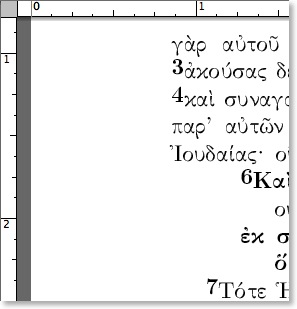
Again, this is an area where I with publishers would realize that those who buy products such as the RGNT appreciate not just thicker paper, but also wide margins for making notes, Regardless, whereas, the first edition's anemic margins were useless for any annotations, the new wider margins begin to approach a minimum width for note-taking,
Mlnl-Lexlcon. For those occasions when the reader forgels one of those words that occur more than 30 times, a new mini-lexicon has been added, presumably in the back of the RGNT.
Maps. Four new color maps have been added to the second edition of the RGNT. Already UBS/NA Greek New Testaments tend to have basic contextual maps inside the front and back covers. With the addition of these maps to the RGNT, this resource begins to take the feel of a standard reference tool and even a one-stop instrument for public use.
And the rest. Like the first edition, the new RGNT comes in an Italian Duo-Tone binding, I've stated before that I like this material just as much as actual leather. Assuming that these covers are going to hold up over decades-long use, I find them to be a very adequate substitute for real leather, especially if this keeps the price down. Perhaps Zondervan could put a disclaimer on the copyright page: "No cows were harmed in the publishing of this New Testament."
And of of course, the RGNT second edition will continue to offer lexical forms of words that occur less than 30 times in the Greek NT as well as noting where the text diverges from the UBS/NA texts. I'm pleased that they continue to keep these notes on the same page as the NT text, in footnote fashion, rather than by some other means.
I'll have more to say about the RGNT2 after I get my hands on one in November, Butfrom what l can already determine, it is already looking to be a great improvement over what was already a very practical and useful resource.
I Guess You Can Sell Just About Anything in a Vending Machine These Days
"A. T. Robertson Is My Homeboy" Apparel and Gifts Now Available
However, you may immediately notice that my design is somewhat different than merely being a knockoff of the Edwards shirt. Since A. T. Roberts is so closely associated with New Testament Greek studies, I thought it would be fitting to offer an equivalent Greek rendering of "is my homeboy." At first, I came up with some awkward phrasing that literally said "A. T. Robertson is the boy of my house." This didn't work, so after some thought and consultation, I cracked open the Louw & Nida lexicon which groups words around semantic domains. I began working my way through the section on "kinship terms." Finally, I came across the word, οἰκεῖος, a derivative of the Greek word for home/house [οἶκος] and which means kinsman, relative or member of a household. The word only occurs three times in the New Testament (Gal 6:10; Eph 2:19; 1 Tim 5:8), and I admit it was not part of my working vocabulary. But after looking at it and getting the opinion of a couple of other folks, I decided that in contemporary terms, in a very, very dynamic rendering, οἰκεῖος could be translated as "homeboy." Thus we have "A. T. Robertson ἐστιν ὁ ἐμὸς οἰκεῖος."
A bit of a stretch? Perhaps, but still valid I believe. Plus, like the "Jonathan Edwards is my homeboy" shirt, this is done somewhat tongue in cheek. I imagine such a shirt would draw quite a few stares, as well as being quite the conversation starter for those who get it and for those to whom you have to explain it.
A. T. Robertson was not only one of the greatest Southern Baptist theologians to have ever lived, but he would still probably rank as one of the most significant scholars in the area of modern New Testament Greek studies. After graduating from the Southern Baptist Theological Seminary in Louisville, Kentucky, Robertson was invited to teach at the school where he remained until his death in 1934. During his lifetime, he wrote over 45 books including four Greek grammars. Many of his works are still in print, and some are now thankfully in the public domain and can be accessed as easily as performing an internet search on his name. Robertson is probably best known for his six volume Word Pictures of the New Testament, a work that he wrote with both the reader in mind who knew Greek and the reader who did not. And of course, Robertson's 1500+ page magnum opus, Grammar of the Greek New Testament in the Light of Historical Research has more than stood the test of time. Although dated in some places, it is still a valuable resource and must for any serious student of NT Greek.
There's such a rich legacy of works left behind A. T. Robertson, that I've often thought of creating a podcast simply based on the reading of selections from his writing. In the meantime, if you want to show your appreciation to this great figure Greek studies, be sure to drop by my Café Press store and pick up a shirt, mug, journal or other item and let the world know, "A. T. Robertson ἐστιν ὁ ἐμὸς οἰκεῖος."



This Lamp Café Press Store Now Open for Business






In all there are over 50 items already available with the This Lamp log including mugs, book backs, and all manner of apparel for men, women, children, toddlers and even your pet.
The logo items are just the beginning. Part of my desire with the Café Press Store is to create really cool items related to biblical history, language and more--the kind of stuff I'd like to wear myself, but never see anywhere else. Later this afternoon, or tomorrow at the latest, I'm going to offer the first real project at the store, which I think many of you are going to get a kick out of.
Am I making a profit? Yes, but very little. I placed what I felt was a very modest markup on the items, and then I went back and made it even more modest. Although I think I have some good ideas, you never really know until you throw it out there. My hope is that the offerings I'm going to make in the future might get popular enough that it could provide a little bit of suplemental income--especially as we're gearing up to make a trip to China next year for our adoption.
You're not going to ever see anything like random Google ads are anything on This Lamp. Yes, there may be items such as these from Café Press and sometimes from Amazon, but these are extremely specific, and will always be something--as in the case of the above items--that I would use or wear myself. And I will.
So stay tuned, and check the store often. There's now a link in the menu at the top left. And if you have any ideas, feel free to send them along.
Biblical Illustrator Plus: Fall 2007
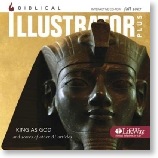
I highly recommend Biblical Illustrator for any student of the Bible's history. The articles are accessible for anyone of almost any background. Even if one has access to journals and such works as the Anchor Bible Dictionary (a favorite of mine), BI is sometimes a faster and more specific resource. And although I could not imagine preparing a Sunday School lesson without it, BI is also valuable for those not using Lifeway's curriculum. Every quarter I take all the articles on the CD (which are in PDF format) and organize them onto my computer's hard drive by biblical book. Then whenever I am preparing a sermon, Bible study, doing research, or anything in which I would need to access historical information about biblical ideas and customs, I have scores of articles at my disposal.
The cover of the Fall issue of BI contains a photograph of the "statue of Amenophis III from his mortuary temple on the West Bank at Thebes, famous for the so-called 'Colossi of Memnon.' Amenophis III was the first Egyptian king to be worshiped as a god in his own lifetime. Eighteenth dynasty, about 1350 B.C." The image relates to the article "King as God" by Joel F. Drinkard, Jr.
The back cover of the CD-ROM case contains these thoughts:
"The God said, 'Let us make man in Our image, according to Our likeness' ...
So God created man in His own image;
He created him in the image of God;
He created them male and female."
--Genesis 1:26-27, HCSB
How simple and yet profound! "Created" changes our origin and destiny. "In His own image" affects our understanding of human dignity, worth, and potential.
Of all creation, God created human beings in His image. That unique feature has compelled mankind to seek, to know, and to worship Him. But, how we have messed that up! People have worshiped everything from nature to creatively fashioned idols. Some have even worshiped man as god. In all of those cases, mankind has missed it.
But "In these last days, [God] has spoken to us by His Son, whom He has appointed heir of all things and through whom He made the universe. He is the radiance of His glroy, the exact expression of His nature, and He sustains all things by His powerful word. After making purification for sins, He sat down at the right hand of the Majesty on high" (Heb. 1:2-3, HCSB). In Him alone do we find worship satisfaction.
Below are the new articles in the Fall 2007 issue of Biblical Illustrator:
| Andrews, Stephen J. | Book Review: Bible Archaeology: An Exploration of the History and Culture of Early Civilizations by Alfred Hoerth and John McRay | |
| Bergen, Robert | Jerusalem's Fall to the Babylonians | Dan 1 |
| Beyer, Bryan E. | Who Were the Medes? | Dan 5 |
| Booth, Steve | Who Were the "Sinners"? | Matt 9, 11, 25 |
| Capes, David B. | First Century Capernaum | Matt 4, 8, 12 |
| Drinkard, Joel F. | The King as God in the Ancient Near East and Israel | Dan 3 |
| Eddinger, Terry W. | Kings and Kingdoms in Daniel's Time | Book of Daniel |
| Gonzalez, Rudy | Almsgiving: Its Use and Abuse | Matt 6:1-18 |
| Gritz, Sharon H. | Judas Iscariot, the Betrayer | Matt 26-28 |
| Jackson, Paul N. | The Righteousness of the Scribes and Pharisees | Matt 5:13-20 |
| Kelly, Bobby | Matthew and His Gospel | Matt 1-2 |
| Lane, Hal | Stranger: A Word Study | Matt 25:31-46 |
| McCoy, Glenn | Joseph the Carpenter | Matt 1, 2, 13 |
| Polhill, John | You Have Heard It Said: Jewish Laws Behind Jesus' Teachings | Matt 5:21-48 |
| Ray, Charles A. | John the Baptist: His Life and Ministry | Matt 3, 11, 14 |
| Roark, C. Mack | Forgiveness and the Jewish Tradition | Matt 18 |
| Stevens, Gerald L. | Divorce in the First Century | Matt 1, 5, 19 |
| VanHorn, Wayne | Belshazzar: All We Know | Dan 5:1-31 |
| Ward, Patrick D. | The "John the Baptist Cave" [ARTifacts] | |
| Weathers, Robert A. | The "Kingdom of Heaven" in Matthew | Matt 12, 13, 16, 19 |
| Wilder, Terry L. | What About the Gospel of Judas? | |
| [CenterSpread] | The Messiah's Ministry: An Account by Matthew |
The articles above are in both the print issue of BI and the BI Plus CD-ROM. However, the articles below are from previous issues and can be found only on the CD-ROM edition.
| Arnold, Stuart | Debtor's Slavery | Matt 18:21-35 |
| Bailey, John | Jesus as "Prophet" | Matt 21:4-14 |
| Boyd, Timothy N. | The Disciples in History and Tradition | Matt 9:36 - 10:1, 27-29 |
| Brooks, James A. | Lawyer and Scribe in the First Century | Luke 10:25; Matt 5:20; 23:1, 23, 27 |
| Caldwell, Daniel | Babylonian and Persian Kings | Dan 3:1-30 |
| Carter, Terry | A Talent | Matt 18:21-35; 25:14-30 |
| Champy III, Harry D. | Belshazzar: All We Know | Dan 5:1-7, 25-28 |
| Cheavens, Alice D. | The Roman Mile | Matt 5:41 |
| Cole, Dennis | First Century Bethlehem | Matt 2:1-12 |
| Cook, Donald E. | Jesus' Use of Parables | Isa 5:1-7 |
| Cook III, William F. | Lamps in Ancient Israel | Matt 5:13-20 |
| Davis, Conn | House Construction in Jesus' Time | Matt 7:24-29 |
| Dehoney, Wayne | The Place of Jesus' "Sermon" | |
| Draper, Charles W. | The Heavenly Host | Ps 148:2-5; 103:20-21 |
| Drinkard, Joel | The Spoils of War | Dan 1:3-5, 8-16 |
| Drinkard, Joel | Wealth, Trade, Money & Coinage in the Ancient World | Prov 16:16; 22:4; 28:20 |
| Dunn, Mark R. | The Blind in Jesus' Day | Matt 9:18-38; 15:16-20 |
| Fowler, R. D. | Zebedee the Fisherman | Matt 20:20-28; Rom 12:9-13 |
| Easley, Kendall H. | Commerce in First-Century Israel | Matt 13:24-52 |
| Easley, Kendall H. | Prayer Customs in First Century Judaism | Matt 6:5-15 |
| Evans, Bob | The Practice of Making Oaths | Matt 5:27-37 |
| Green, Joe | The Learning and Wisdom of Chaldea | Dan 1:17 |
| Gregg Sr., D. Larry | The House of Herod | Isa 9:6-7; Matt 1:18-23; 2:1-2, 9-11 |
| Gritz, Sharon | Kingdom of God in Intertestamental Judaism | Matt 13:1-23; 13:24-52; 16:13-28 |
| Gritz, Sharon | Pilate's Power and Authority | Matt 28 |
| Haag, H. Joseph | The Early Church's View of Poverty | John 12:5; James 2:15-16 |
| Hall, Kevin | Apocalyptic Literature | Books of Daniel and Revelation |
| Hankins, L. Milton | Beams & Motes | Matt 7:1-12 |
| Huckaby, Gary C. | Caesarea Philippi | Matt 16:13 |
| Jackson, Paul | Jesus' Last 40 Days | Matt 28:1-10 |
| Jones, Timothy Paul | The Meaning of "Raca" | Matt 5:21-26 |
| Knight, George W. | The Galilee Boat | Matt 14:22-33 |
| Knowles, Julie Nall | The Church's Use of the Model Prayer | Matt 6:9-15 |
| Lain, Gil | Ancient Storage Facilities | Matt 6:26 |
| Lain, Gil | Early Ships and Boats | Matt 14:29 |
| Lane, Hal | Worry: a Word Study | Matt 6:25-34 |
| Lanier, David E. | Salt in Ancient Israel | Matt 5:1-16 |
| Lemke, Steve W. | "Falling Away" or "Erring" from the Faith? | 1 Tim 4:1; 6:10 |
| McCoy, Glenn | God as Heavenly Father | Matt 5:45, 48 |
| McCoy, Glenn | The Mount of Transfiguration | Matt 17:1-13 |
| McGraw, Larry | God's Angelic Messengers in the New Testament | Psalm 103:20-21; Matt 13:39-42; Mark 13:26-27; Acts 12:7-9, 11; 27:23-24 |
| McWilliams, Warren | Predestination: Time and Space | Matt 6:8 |
| Miller, Stephen R. | Capital Punishment in the Ancient Near East | Dan 3; Esth 4:11 |
| Miller, Stephen R. | The Neo-Babylonian Empire | Book of Daniel |
| Moseley, Allan | Shadrach, Meshach, and Abednego: All We Know | Dan 1:8, 14-17; 3:17-18, 26-28 |
| Parsons, Mikeal C. | The Holy Spirit: A History of Interpretation | Rom 5:5 |
| Patterson, Bill | Divorce in First Century Israel | Matt 19:4-6, 10-12; Rom 16:3-5a; 1 Cor 7:7-9, 32-35; Eph 5:21-22, 25 |
| Peacock, Kevin C. | The Battle of Carchemish | Books of Ezekiel and Daniel |
| Poulton, Gary | The Roman Military in Jesus' Day | Matt 8:1-13 |
| Pouncey, Greg | Who Were the Magi? | Matt 2:1-23 |
| Rathel, Mark | Salvation: A Word Study | Luke 2:25-38 |
| Reeves, Rodney | Mourning the Dead in the First Century | Matt 9:18-31; 36-38 |
| Register, Dean N. | Jesus as the Son of God | Matt 3:17; 4:3 |
| Roberts, Sharon | Pearls in the Ancient World | |
| Robertson, Paul E. | The Love of Money | 1 Tim 6:10 |
| Robinson, Dale G. | The Trumpet in the New Testament | Matt 24:3-6, 29-31, 42-47 |
| Sandlin, Bryce | A History of Darius I | Dan 6:1-28 |
| Simmons, Billy E. | Poverty and Wealth in the Early Church | Matt 6:1-18 |
| Tench, Tony | The Pure in Heart | Matt 5:3-12 |
| Trammell, Timothy | Introducing Matthew's Gospel | Matt 2:1-12 |
| Ward, Patrick D. | City Gates in Jesus' Day | Matt 7:13-29 |
| Ward, Patrick D. | Jesus' Early Life | |
| Warren, William | Our English Bible | |
| Wood, Darryl | Prayer: Its History and Use | 1 Thess 5:17 |
| Woodward, C. Alan | Annas and Caiaphas | Matt 26:1-56; John 18:15-27; 19:1-42 |
| Woodward, C. Alan | "Mammon" | Matt 6:19-24 |
Finally, I was honored to be quoted in an ad for Biblical Illustrator appearing in one of Lifeway's publications this quarter. Here is a reproduction of the ad below. Click on the image to see a larger version.
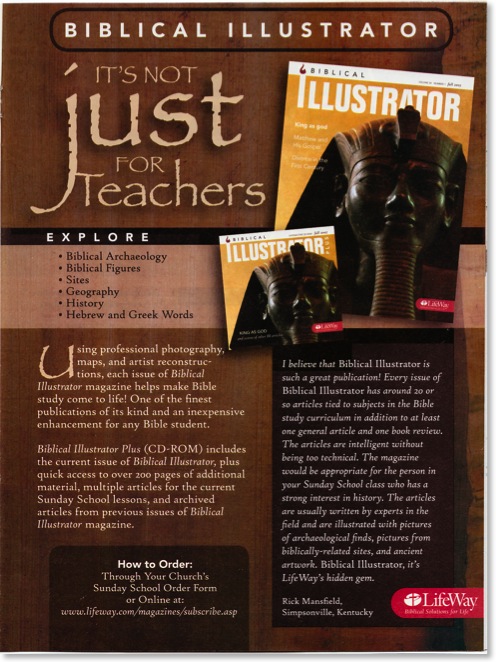
Apple Store: Oxmoor/Grand Opening Pictures, Reflections
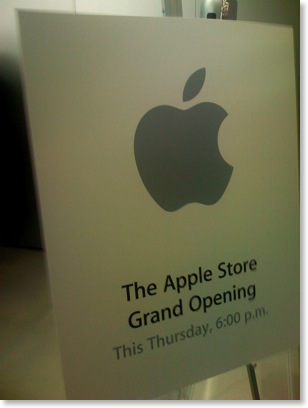
Okay, I admit it. I'm the kind of person who will stand in line for stuff like this. I've seen quite a few midnight showings of movies on their release day. In 2004 I stood in line to get a copy of Halo 2 for the Xbox at midnight. A couple of months ago, I stood in line to to get an iPhone on its launch date. What's wrong with me (and others who do the same thing)? Am I simply too impatient? Did I have to be at the Oxmoor Mall for the grand opening of Louisville's new Apple Store? I mean couldn't I go this weekend and avoid all crowds?
Certainly. But that's not why we go.
Such activities are an event themselves, a pinpoint in one's personal history that merges with the history of significant cultural events. Standing in line with folks you don't know personally, but with whom you obviously have much in common makes for great conversation despite a lack of personal history. You can look back and say, "I was there--there on the very first day."

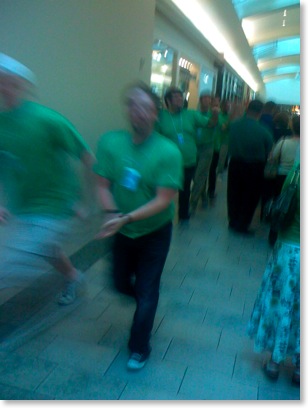
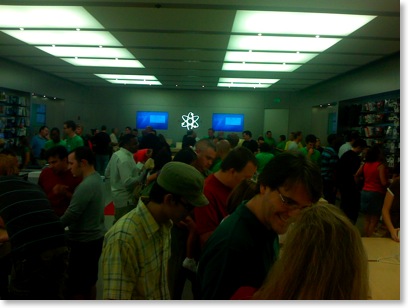


All of the sales people were extremely friendly. I didn't leave to cheers (because I didn't purchase anything), but I did get my t-shirt and friendly farewells from the Apple Store employees. One of the workers, a young man in his twenties with bright red hair said to me, "Isn't this great?!" He seemed just as enthusiastic about being an employee as the rest of us felt about being customers. I said, "Yeah. Hey, are there any grand opening specials going on tonight?" I hadn't seen any indication of such, but often stores such as Best Buy will offer tremendous sale price savings for the entire week when a new store is opens. He smiled, and without hesitation said, "No, really the free t-shirt is the special tonight." Makes sense. There was a steady stream of people to get in, and another steady stream of people walking out with iPods, iPhones, and iMacs. Why on earth would they need to run specials. Cult of Mac, indeed.
But at least I got my t-shirt.
Don't forget to see all my pictures of the Apple Store Oxmoor Grand Opening at my web gallery.











